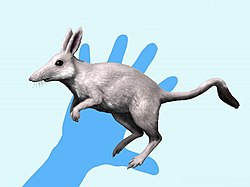Description
Proborhyaena was very large in size, with the skull alone reaching up to 60 cm (2.0 ft), [1] and the whole animal may have been as large as a present-day spectacled bear. [2] Sorkin (2008) speculated that Proborhyaena gigantea may have weighed up to 600 kg (1,300 lb), [3] but subsequent studies consider this an overestimate and argue that it would have weighed up to 90–200 kg (200–440 lb). [4] [2] [5]
Proborhyaena was a massive animal, with a robust and powerful body. Its skull was equipped with a short, high snout, and its caniniform teeth were saber-shaped, although not as developed as those of the later Thylacosmilus . The canines, in contrast to those of Thylacosmilus , which had an "almond-shaped" section and a sharp margin, were ovoid in cross-section and thus would have been much more robust. Like the thylacosmilids, Proborhyaena possessed only one pair of lower incisors. [6]
This page is based on this
Wikipedia article Text is available under the
CC BY-SA 4.0 license; additional terms may apply.
Images, videos and audio are available under their respective licenses.





